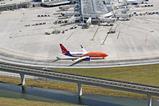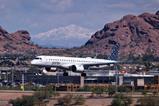Southwest Airlines is considering selling some of its older Boeing 737-800s and newer 737 Max jets, in addition to executing aircraft sale-leaseback deals, to boost its weakened financial position.
Chief executive Bob Jordan discussed Southwest’s plans to leverage its current and incoming narrowbody Boeing jets during its investor day on 26 September, as the company unveiled a sweeping strategic overhaul aimed at recapturing its lost form.
“We have a unique opportunity to capture value and earnings on excess aircraft we do not need with our moderate growth plan,” Jordan says. ”With that in mind, we are pursuing direct sales of [737]-800 aircraft. We are also looking at sale-leaseback where we can be opportunistic.”
Demand for narrowbody jets is strong thanks to Boeing’s ongoing delivery delays – compounded by what increasingly looks like a protracted machinists’ strike – and the recall of hundreds of Pratt & Whitney’s geared turbofan (GTF) engines, which power Airbus A320neo and A220 aircraft. Those constraints are causing slower-than-anticipated growth for airlines around the world.
“So, the secondary market for used aircraft is going to stay strong for literally years to come,” Jordan says. “The implication is that we have a lot of flexibility [for] sale-leasebacks on the -800s and the new Maxes.”’

Sale-leaseback transactions involve an airline selling its aircraft to a lessor and leasing them back as a means of generating cash. It is a strategy often employed by ultra-low-cost carrier Frontier Airlines.
”Southwest needing to borrow from Frontier’s playbook is pretty sad commentary,” William Swelbar of the Swelbar-Zhong Consultancy opines on social media. He and other airline analysts believe it would be a mistake for Southwest’s recovery plan to rely too heavily on such financial manoeuvres.
Chief financial officer Tammy Romo says leveraging the value of Southwest’s all-737 fleet is not a “core” part of its revamp.
“We can get to our ROIC [return on invested capital] goal without our fleet strategy,” she says.
The company’s financial performances have sputtered in recent quarters, as it reported a $137 million profit in the year’s first half – down 74% year on year. Southwest is under intense pressure from minority stakeholder Elliott Investment Management and other investors to return to consistent profitability.
Jordan says the company is on a path to sustained success with a range of changes to its network, aircraft cabins, boarding processes and flight schedules. If effective, the initiatives would save between $500-$700 million annually by 2027, at which point the company hopes to have returned to double-digit profit margins.
Until then, Southwest is planning for annual capacity growth of 1-2%.
Southwest aims to have by 2031 an-all new fleet of 737 Max jets with an average age of five years old, as the older 737NGs are sold and retired. Such a modern fleet could allow for a period in the 2030s of “very few” aircraft retirements and minimal capital costs, Jordan says.
The carrier has 243 737 Max in service and 480 on order from Boeing, according to Cirium fleets data. That includes 285 slots for the 737 Max 7, the smallest variant in the Max family. The type has yet to be certificated by the Federal Aviation Administration.
Andrew Watterson, Southwest’s chief operating officer, told reporters that the company does not regret opting for the Max 7 versus GTF-powered A220s, because many of those Airbus jets are grounded for P&W engine inspections.
“The Max 7 still looks like the right call,” he says. “We are disappointed that it’s late but it’s not affecting our plans at the moment. But eventually we need it.”
Whether Southwest will sell some of the 737 production slots its holds with Boeing is an open question that Jordan declines to address specifically.
“Our agreement with Boeing, and what we can and can’t do, is obviously very confidential,” he says. “We’re committed to extracting all of our orderbook’s value, and we have a number of techniques to be able to do that.”































